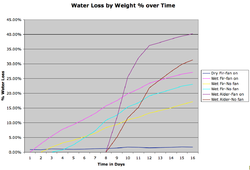I need some help here. We all know seasoned wood burns better than green wood. What I am trying to do is show a friend how much heat he looses by burning green wood. So I want to figure out how many btu's are in different woods. How many btu's it takes to boil off the water in it. And find out the net difference between a chunk of green wood and what it would be seasoned.
So I'll start with poplar since I know it hold a lot of water. I believe I hear it was 60% water while growing.
A cord of poplar weighs 2168 lbs and has 15,000,000 btu. (it did not say if the it was green or seasoned)
Shoot I don't have a scale whats a good sized split weigh? 5lbs?
15,000,000 divided by 2186 = 6861
So poplar has 6861 but's per pound (if I am doing that right) and say its 50% water thats .5 lbs of water and we need 575 btu's we have to take out of the poplars' total. Oops if it wet 50% I only have a half pound of wood so 3430.5 btu's minus 575 leaves me 2855.5 btu's net.
Ok I confused myself do you see where I am trying to go?
Billy
BTUs to Evaporate One Pound of Water
Quick Answer: Somewhere around 1000BTU/lb
Long answer: It depends on the temperature of the water you start with. Before you can evaporate the water, you must heat it to it's boiling point. The warmer the water you start with the fewer BTUs will be needed to heat the water to its boiling point. Keep in mind the BTUs require to raise the water to its boiling point are very few compared to the BTUs required to change the water from a liquid to a gas.
One pound of steam contains 1150 BTUs. This is the energy you need to put into the water for it to evaporate if you start with water at 32F. If you start with water at 100F the water already has 70 BTU/lb so the BTUs required to evaporate the water when you start at 100F is 1150-70 = 1080 BTU and so on.
Read more: http://wiki.answers.com/Q/How_many_BTU's_does_it_take_to_evaporate_one_pound_of_water#ixzz16sOe7kda
quote from answers. com
So I'll start with poplar since I know it hold a lot of water. I believe I hear it was 60% water while growing.
A cord of poplar weighs 2168 lbs and has 15,000,000 btu. (it did not say if the it was green or seasoned)
Shoot I don't have a scale whats a good sized split weigh? 5lbs?
15,000,000 divided by 2186 = 6861
So poplar has 6861 but's per pound (if I am doing that right) and say its 50% water thats .5 lbs of water and we need 575 btu's we have to take out of the poplars' total. Oops if it wet 50% I only have a half pound of wood so 3430.5 btu's minus 575 leaves me 2855.5 btu's net.
Ok I confused myself do you see where I am trying to go?
Billy


 But if I give him too many options he'll try to figure the angles in a way to make it look like what he is doing is the right way.
But if I give him too many options he'll try to figure the angles in a way to make it look like what he is doing is the right way.
